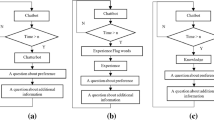Abstract
Conversation is a natural and powerful means of communication for people to collaboratively create and share information. People are skillful in expressing meaning by coordinating multiple modalities, interpreting utterances by integrating partial cues, and aligning their behavior to pursuing joint projects in conversation. A big challenge is to build conversational artifacts – such as intelligent virtual agents or conversational robots – that can participate in conversation so as to mediate the knowledge process in a community. In this article, I present an approach to building conversational artifacts. Firstly, I will highlight an immersive WOZ environment called ICIE (Immersive Collaborative Interaction Environment) that is designed to obtain detailed quantitative data about human-artifact interaction. Secondly, I will overview a suite of learning algorithms for enabling our robot to build and revise a competence of communication as a result of observation and experience. Thirdly, I will argue how conversational artifacts might be used to help people work together in multi-cultural knowledge creation environments.
Access this chapter
Tax calculation will be finalised at checkout
Purchases are for personal use only
Preview
Unable to display preview. Download preview PDF.
Similar content being viewed by others
References
Kitsuregawa, M., Nishida, T.: Special Issue on Information Explosion. New Generation Computing 28(3), 207–215 (2010)
Nishida, T.: Social Intelligence Design for Cultivating Shared Situated Intelligence. In: GrC 2010, pp. 369–374 (2010)
Nishida, T. (ed.): Conversational Informatics: an Engineering Approach. John Wiley & Sons Ltd., London (2007)
Clark, H.H.: Using Language. Cambridge University Press, Cambridge (1996)
Kendon, A.: Gesture. Cambridge University Press, Cambridge (2004)
McNeill, D.: Gesture and Thought. The University of Chicago Press, Chicago (2005)
Cassell, J., Sullivan, J., Prevost, J., Churchill, E. (eds.): Embodied Conversational Agents. The MIT Press, Cambridge (2000)
Prendinger, H., Ishizuka, M. (eds.): Life-like Characters – Tools. Affective Functions and Applications. Springer, Heidelberg (2004)
Kubota, H., Nishida, T., Koda, T.: Exchanging Tacit Community Knowledge by Talking-virtualized-egos. In: Proceedings of Agent 2000, pp. 285–292 (2000)
Nishida, T.: Social Intelligence Design for Web Intelligence, Special Issue on Web Intelligence. IEEE Computer 35(11), 37–41 (2002)
Okamoto, M., Nakano, Y.I., Okamoto, K., Matsumura, K., Nishida, T.: Producing Effective Shot Transitions in CG Contents based on a Cognitive model of User Involvement. IEICE Transactions of Information and Systems Special Issue of Life-like Agent and Its Communication, IEICE Trans. Inf. & Syst. E88-D(11), 2532–2623 (2005)
Huang, H.H., Cerekovic, A., Pandzic, I., Nakano, Y., Nishida, T.: The Design of a Generic Framework for Integrating ECA Components. In: Proceedings of 7th International Conference of Autonomous Agents and Multiagent Systems (AAMAS 2008), Estoril, Portugal, pp. 128–135 (2008)
Huang, H.H., Furukawa, T., Ohashi, H., Nishida, T., Cerekovic, A., Pandzic, I.S., Nakano, Y.I.: How Multiple Concurrent Users React to a Quiz Agent Attentive to the Dynamics of their Game Participation. In: AAMAS 2010, pp. 1281–1288 (2010)
Nishida, T., Terada, K., Tajima, T., Hatakeyama, M., Ogasawara, Y., Sumi, Y., Yong, X., Mohammad, Y.F.O., Tarasenko, K., Ohya, T., Hiramatsu, T.: Towards Robots as an Embodied Knowledge Medium, Invited Paper, Special Section on Human Communication II. IEICE Transactions on Information and Systems E89-D(6), 1768–1780 (2006)
Ohashi, H., Okada, S., Ohmoto, Y., Nishida, T.: A Proposal of Novel WOZ Environment for Realizing Essence of Communication in Social Robots. Presented at: Social Intelligence Design 2010 (2010)
Mohammad, Y.F.O., Nishida, T., Okada, T.: Unsupervised Simultaneous Learning of Gestures, Actions and their Associations for Human-Robot Interaction. In: IROS 2009, pp. 2537–2544 (2009)
Mohammad, Y.F.O., Nishida, T.: Learning Interaction Protocols using Augmented Baysian Networks Applied to Guided Navigation. Presented at: IROS 2010, Taipei, Taiwan (2010)
Rehm, M., Nakano, Y.I., André, E., Nishida, T.: Culture-Specific First Meeting Encounters between Virtual Agents. In: Prendinger, H., Lester, J.C., Ishizuka, M. (eds.) IVA 2008. LNCS (LNAI), vol. 5208, pp. 223–236. Springer, Heidelberg (2008)
Thovuttikul, S., Lala, D., Ohashi, H., Okada, S., Ohmoto, Y., Nishida, T.: Simulated Crowd: Towards a Synthetic Culture for Engaging a Learner in Culture-dependent Nonverbal Interaction. Presented at: 2nd Workshop on Eye Gaze in Intelligent Human Machine Interaction, Stanford University, USA (2011)
Author information
Authors and Affiliations
Editor information
Editors and Affiliations
Rights and permissions
Copyright information
© 2011 Springer-Verlag Berlin Heidelberg
About this paper
Cite this paper
Nishida, T. (2011). Towards Conversational Artifacts. In: Hu, B., Liu, J., Chen, L., Zhong, N. (eds) Brain Informatics. BI 2011. Lecture Notes in Computer Science(), vol 6889. Springer, Berlin, Heidelberg. https://doi.org/10.1007/978-3-642-23605-1_4
Download citation
DOI: https://doi.org/10.1007/978-3-642-23605-1_4
Publisher Name: Springer, Berlin, Heidelberg
Print ISBN: 978-3-642-23604-4
Online ISBN: 978-3-642-23605-1
eBook Packages: Computer ScienceComputer Science (R0)





